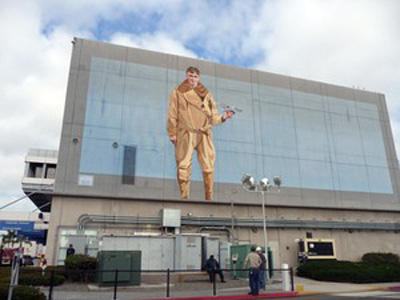
By Donald H. Harrison

SAN DIEGO – Whether it’s the Commuter Terminal mural of Charles A. Lindbergh by John J. Whalen, the sculpture by Paul T. Granlund at Terminal Two representing him as a boy and as a man, the bust by Paul Fjelde or the scale model of “The Spirit of St. Louis,” created by the San Diego Aerospace Museum near the airport’s baggage area, it is clear that San Diego’s Lindbergh Field has a special bond with the pioneer aviator and namesake.
Oh sure, the City of St. Louis had been honored with the name of the famous plane in which Lindbergh made the first solo flight across the Atlantic Ocean, from Roosevelt Field in New York to Le Bourget Field in Paris, beginning at 7:52 a.m., May 20, 1927, and covering a distance of 3,610 miles in 33 ½ hours.
However, that was because businessmen in his hometown had put up the $10,580 it cost to build the machine in just 60 days. Truth be known, the plane really should have been called “The Spirit of San Diego,” because this was the city where it was built by workers of Ryan Aeronautical Corporation.
Furthermore, San Diego had become known as a city of aviation firsts—in large measure because the Navy was testing the possibilities of aviation at Rockwell Field on North Island, just across the bay from today’s Lindbergh Field. On its website, the San Diego Airport Authority reports: “San Diego is responsible for setting more than 42 historical ‘firsts’ in aviation. These include records for altitude, distance, speed, duration, in-flight refueling and aerial photography. Others include the first aviation radio and the first night flight.”
Ryan Aeronautical had built The Spirit of St. Louis to Lindbergh’s specifications –27-feet 7 inches long, 9 feet, 10 inches high, and with a wingspan of 46 feet. It had a compartment in front of the cockpit for carrying 450 gallons of gas, which blocked his forward view and required him to lean out the side windows to see ahead of him. The cockpit was so small that Lindbergh didn’t have room to stretch his legs. But for all its physical drawbacks, the plane and its Wright J-5C “Whirlwind” radio engine had the stamina to take him across an expanse no pilot had navigated before and win for him the $25,000 Orteig Prize.
Satisfied that Ryan had met his expectations, the pilot had workers sign their names to a propeller spinner designed with what has been described as a good-luck symbol of a left-facing “Native American swastika”—a symbol that would become identified only a few years later with the Nazi movement in Germany. Lindbergh’s choice of symbol presaged the controversy he would attract later in his career as an opponent of American war against Germany—a position that prompted President Franklin D. Roosevelt to publicly chastize him.
After accepting the aircraft from Ryan Aircraft, Lindbergh flew a circle around Dutch Flats (near the modern site of the main Midway Post Office), crossed San Diego Bay, and then described a circle around Rockwell Field on North Island, before heading for St. Louis, New York, Paris, celebrity and aeronautical history.
Lindbergh and The Spirit of St. Louis returned to the United States aboard the USS Memphis and were greeted by President Calvin Coolidge, who conferred upon him the Distinguished Flying Cross. Soon thereafter, financed by aviation enthusiast Daniel Guggenheim, he began a tour of the United States to urge construction of airport facilities. That tour brought him on September 21, 1927 back to San Diego.
He again flew over Ryan Field and Rockwell Field, and also thrilled a crowd waiting for him at city stadium in Balboa Park by circling eight times and dipping his wings. He then landed at Ryan Field from which he was accompanied by a parade to the stadium. Historian Gerald A. Shepard, writing in the Winter 1994 edition of The Journal of San Diego History, reported that the crowd of 60,000 waiting for him was the largest assembly in San Diego’s history, containing 10,000 more spectators than had turned out to hear President Woodrow Wilson campaign for the League of Nations.
After being welcomed by local speakers, Lindbergh gave a speech that lasted only five minutes, in which he said that “planes need airports as cars need a system of good roads. A city needs an airport near the business district of the town.” San Diego’s Lindbergh Field today is so close to town that pilots call the steep descent over the high-rise buildings a “white-knuckle” landing.
Following the speech, Lindbergh engaged in newspaper interviews at the home of Franklin Mahoney, who had purchased Ryan Aircraft from his former partner Claude Ryan. Next he was driven to the Hotel del Coronado where a citizen’s banquet in his honor featured comedian Will Rogers, who mused humorously what’s the need for air mail—given that the only thing in the letter is likely to contain is a real estate advertisement.
The following day, Lindbergh went to Russ Auditorium where San Diego Mayor Harry Clark was among the dignitaries who inducted him into the Ancient Egyptian Order of Sciots, a social club for Masons. After making a quick round trip to Los Angeles in a Ford Trimotor plane, Lindbergh participated in a factory banquet for employees of Ryan/Mahoney Aircraft to thank them for the work they did on his historic plane.
From San Diego, Lindbergh flew to Tucson, and from there hopscotched across the country, carrying his pro-aviation message. Historian Shepard said the Lindbergh tour covered 22,350 miles, 82 cities, and 147 speeches. An estimated 30 million people had turned out to hear his message.
San Diego dedicated Lindbergh Field at its present site on August 16, 1928, less than a year after the pilot’s triumphal return visit to the city where the aviation adventure had begun.
*
Harrison is editor of San Diego Jewish World. This article appeared prevously on examiner.com